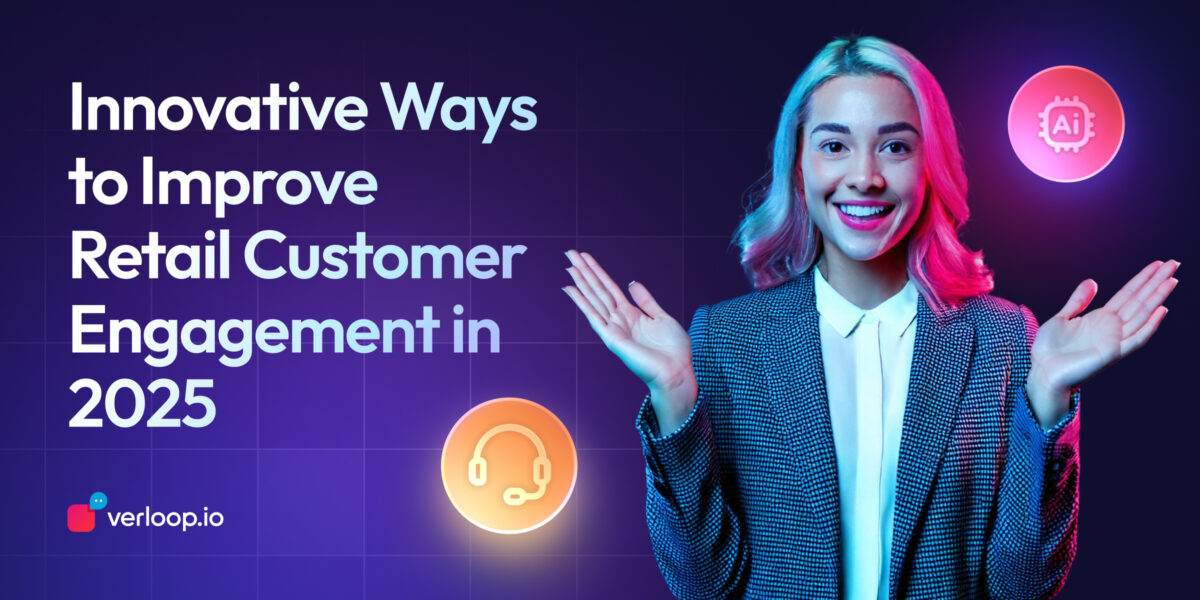Innovative Ways to Improve Retail Customer Engagement in 2025
- May 26th, 2025 / 5 Mins read
-
Harshitha Raj

Innovative Ways to Improve Retail Customer Engagement in 2025
- May 26th, 2025 / 5 Mins read
-
Harshitha Raj
Customer expectations in retail have shifted substantially over time from traditional brick-and-mortar shopping to the ease of home deliveries. This shift reflects a more significant cultural trend towards digitalisation and ease. Today’s consumers want seamless, personalised experiences combining online and offline worlds. With the development of e-commerce platforms like Amazon and the emergence of technologies such as augmented reality (AR) and artificial intelligence (AI), businesses must adapt to satisfy these changing expectations while remaining competitive.
According to Business.com on average, current clients spend 67% more than those who are new to the company. Fresh techniques emphasising consumer interaction and satisfaction are required to succeed in this environment. Let’s look at some of the ways regarding how to increase retail customer engagement on websites in greater depth.
Understanding the Retail Landscape in 2025
If 2024 was the year of AI buzz, 2025 is shaping up to be the year retailers truly put it to work. From small businesses to global brands, there’s a clear shift towards embedding artificial intelligence not just into operations, but also into everyday customer experiences — often without customers even realising it.
A recent Verizon Business and Morning Consult survey revealed that 39% of SMBs are using AI in 2024, more than double the previous year. Meanwhile, Syndigo’s research shows that 9 out of 10 retailers have adopted generative AI to enhance customer experiences. Yet, according to a Bain & Company survey, a whopping 71% of US online shoppers were unaware they’d interacted with generative AI — highlighting a subtle but significant integration of tech in retail.
As we move into 2025, the focus will be on strategic cost management, margin improvement, and working capital optimisation — all while staying agile in response to cultural shifts and consumer expectations. But it’s not just about tech and profits.
Retailers are also doubling down on attracting and retaining talent in a highly competitive market. This includes:
Upskilling and augmenting employee skills with technology like AI agents and decision-making tools.
Creating safe, inclusive, and wellbeing-focused environments, especially for frontline staff.
Encouraging bold, strong leadership that can pivot quickly and steer teams through ambiguity.
2025’s retail leaders won’t just be tech-savvy — they’ll be culture-driven, empathetic, and prepared to lead in a world where change is the only constant.
Why is Retail Customer Engagement so Important?
Retailers today are constantly investing in acquisition — chasing clicks, conversions, and campaign performance. But what often gets overlooked are the moments in between. These moments, where customers aren’t actively buying but still interacting with your brand, are where emotional loyalty is built — and where real differentiation happens.
According to Salesforce, 65% of customers expect companies to adapt to their changing needs and preferences, yet 61% feel that most companies treat them like just another number. The disconnect is clear: expectations are high, but personalisation is still lacking.
Engaging customers beyond transactions helps keep your brand top-of-mind, especially when they’re ready to make a decision. It also makes them more responsive to marketing efforts, increases the likelihood of upsells and cross-sells, and ultimately raises your average order value.
Let’s take a simple, real-world example.
Imagine two home appliance retailers with online stores.
- The first one invests in a strong customer engagement strategy. They offer personalised product recommendations based on past purchases, proactively share maintenance tips post-sale via WhatsApp, and invite customers to rate their experience and suggest improvements. When they introduced a new blender model shaped by customer feedback, it wasn’t just a launch — it felt like a collaboration. Customers felt involved and appreciated, leading them to share reviews, tag the brand online, and recommend it to others.
- The second retailer simply lists products online and sends the same promotional emails to every shopper. There’s no follow-up post-purchase, no way for customers to share input, and no personalised interaction. Over time, their sales dip. Customers start choosing brands that offer more than transactions — brands that listen, remember, and respond.
What made the difference?
Thoughtful engagement.
Customer engagement isn’t just a retention tool — it’s a growth engine. Brands that truly listen, adapt, and interact with customers meaningfully build long-lasting relationships that pay off in both revenue and reputation.
12 Key Strategies For Retail Customer Engagement
Engaging customers effectively in retail is critical for increasing sales and building loyalty. Here are 12 significant strategies for retail consumer engagement:
1. Personalise Retail Customer Experience
Personalising the retail experience for the customer has become a crucial strategy for increasing customer engagement and loyalty. One strategy is to use consumer data and insights to customise product recommendations and promotions based on individual tastes and behaviours. Retailers can provide personalised recommendations that appeal to customers’ tastes and interests by analysing purchase history, browsing trends, and demographic data.
2. Leverage AI to Engage Customers
Artificial Intelligence (AI) provides retailers with new capabilities for increasing customer engagement and delivering personalised experiences at scale. Machine learning-powered recommendation engines are one approach to using AI for retail consumer engagement. Conversational AI improves customer engagement by giving immediate, personalised responses, effectively resolving problems, and providing 24/7 service. This results in higher customer satisfaction, smoother interactions, and a more delightful overall experience.
3. Offer Omnichannel Support
Omnichannel help is crucial to retail consumer engagement. It provides a uniform and smooth experience across all platforms, including in-store, internet, and mobile apps. Customers may easily switch between different channels when integrated, improving ease and happiness. This approach fulfils many customer preferences, fosters loyalty, and promotes sales through a consistent purchasing experience.
4. Capture the Metaverse Space
Capturing the Metaverse space entails constructing immersive, interconnected virtual spaces where users can interact, socialise, and engage in diverse activities. This place offers one-of-a-kind experiences by combining augmented reality (AR), virtual reality (VR), and blockchain technology. Businesses and developers may capitalise on the Metaverse by creating virtual stores, holding events, and providing digital assets, changing how we connect and transact online.
5. Add Augmented Reality(AR) Capabilities
Adding Augmented Reality (AR) capabilities boosts user engagement by superimposing digital information and graphics on the actual world. In retail, AR enables customers to visually try on things, visualise how furniture will fit in their homes, and access interactive product information via smartphones. This technology improves the shopping experience, lowers return rates, and boosts customer happiness by allowing for a more educated and personalised connection with products before purchase.
6. Provide a Smooth Return/Exchange Experience
Making it simple for customers to return or exchange their purchases is a significant opportunity many companies miss. Simple, no-hassle returns are frequently a motivator for purchasing in the first place. It also indicates that you are available to your consumers at all stages of their journey. Beyond that, refunds provide an excellent opportunity to improve the consumer experience. Retailers can analyse data to discover if any issues can be readily resolved.
7. Focus More on Analytics & Insights
Analytical and insight-driven thinking is critical for understanding customer behaviour and optimising corporate strategy. Businesses can use data analytics to track client preferences, purchase trends, and feedback. This information allows for targeted marketing, personalised recommendations, and inventory management. Data insights help retailers spot trends and opportunities, helping them to make more informed decisions, improve consumer experiences, and drive growth. Finally, analytics provides a competitive advantage by converting raw data into actionable solutions.
8. Become Highly Interactive and Responsive
Being very involved and responsive is essential for developing good customer relationships. This entails actively engaging with customers via numerous channels, swiftly responding to their requests and feedback, and offering real-time support. Social media, chatbots, and live chats can improve interaction, making customers feel appreciated and heard. A responsive approach resolves issues promptly and builds trust and loyalty, resulting in higher customer satisfaction and repeat business.
9. Integrate Online and Offline Shopping Experiences
Integrating online and offline shopping experiences is critical to current retail success. This method creates a seamless trip that lets customers quickly switch between digital and physical stores. Click-and-collect, online inventory checks for in-store products, and in-store digital kiosks increase convenience. Personalisation technologies can be used in stores, such as tailored recommendations based on online behaviour. This integration provides a consistent buying experience, increasing customer satisfaction, loyalty, and earnings by catering to varied consumer preferences.
10. Streamline Mobile Shopping Experience
Brands can effectively employ mobile shopping for retail consumer engagement by optimising the experience for ease and accessibility. This involves providing a user-friendly interface, quick loading times, and easy navigation. Implement features like mobile-exclusive bargains, personalised suggestions based on previous purchases or browsing history, and fast access to customer service. Keep consumers interested and informed by using push notifications to notify them of new products, specials, or things that are back in stock.
11. Build Brand Communities
Building brand communities helps customers feel a feeling of connection and loyalty. This entails developing online and offline areas where customers can connect, share their experiences, and interact with the business. Using social media groups, forums, and sponsored events promotes interaction and deepens connections. Engaging material, such as user-generated posts, special discounts, and behind-the-scenes looks, keeps the community going. A strong brand community encourages repeat purchases and converts customers into champions who promote positive word of mouth.
12. Gain Trust Through Sustainable Initiatives
Businesses committed to social responsibility must build trust through long-term initiatives. Companies demonstrate their commitment to sustainability by employing ecologically friendly activities such as lowering carbon emissions, minimising waste, and ethical sourcing. Transparent communication about these efforts fosters trust among consumers, who increasingly value environmentally diligent companies. Investing in sustainable initiatives benefits the earth while improving business reputation, increasing customer loyalty, and attracting ecologically concerned consumers.
Successful Retail Engagement Stories
Here are the three successful retail engagement stories with different headings for each:
Starbucks
Starbucks’ mobile app has changed the coffee shop experience by seamlessly connecting digital and physical channels. Customers may order ahead of time, collect rewards, and pay with the app, which improves ease and personalisation. Starbucks uses consumer data to give targeted specials and recommendations, which drives return visits and increases customer happiness. The app’s popularity stems from its ability to expedite ordering while providing a personalised experience for each user.
NikePlus
Nike’s NikePlus membership programme is notable for its ability to foster a strong feeling of community among members. Nike drives long-term engagement and loyalty by providing exclusive benefits such as personalised product suggestions, early access to new releases, and member-only events. Members may access workouts, engage with Nike experts, and participate in challenges via the Nike app and in-store experiences, deepening their relationship with the brand.
Sephora Beauty
Sephora’s Beauty Insider programme demonstrates how personalised experiences may boost customer engagement and loyalty in the beauty retail industry. Members receive personalised product suggestions, event access, and prizes based on purchasing history and preferences. Sephora uses data analytics to provide personalised incentives and prizes, creating a sense of community among beauty fans. The Beauty Insider programme promotes continued connection with the company, resulting in greater customer loyalty and happiness.
Key Metrics For Measuring and Improving Engagement
And now, for the good stuff—the critical indicators and KPIs you need to assess client engagement. You may not need to measure all, and in most circumstances, you will not, but you should be aware of them.
CSAT
How many times have you gotten off the phone with a customer service agent or a chat with a chatbot and been given a one-question survey about your customer satisfaction? Every single time, right? This type of question is used to calculate the customer satisfaction score (CSAT). The CSAT metric measures how happy your customer is with your service or product, and it is usually asked after a customer experience or feedback survey. CSAT is often assessed on a scale of 0 to 5, and you can calculate it by dividing the total number of four and five responses by the total number of survey responses and multiplying by 100 to get your percentage score.
Social Media Metrics
Likes, comments, shares, and overall reach are all ways to measure and improve social media engagement. These metrics measure consumers’ interaction with your material and how far it is spread. Tracking click-through rates, conversion rates, and the number of followers gained over time can also provide insights into how effective your engagement efforts are. Regular analysis of these indicators allows for modifications and optimisations to improve engagement.
Sales and Repeat Orders
Sales and repeat orders are critical factors for a company’s performance and long-term survival. Sales data show the income generated by product or service transactions, which represent market demand and the efficacy of marketing and sales operations. Repeat orders show client satisfaction and loyalty by indicating a propensity to make additional purchases. Monitoring these data enables organisations to assess client retention methods, uncover chances for upselling or cross-selling, and ultimately drive long-term profit.
Feedback and Reviews
Feedback and reviews are vital in shaping brand reputation and consumer perception. They provide helpful information about client satisfaction, product quality, and opportunities for improvement. Positive feedback and reviews can increase credibility, trust, and sales. Negative feedback, conversely, emphasises issues that need to be addressed and provides opportunities for improvement. Regularly monitoring and responding to comments and reviews demonstrates a dedication to the customer experience and can help you build closer ties with your audience while driving ongoing improvement initiatives.
Customer Effort Score (CES)
Customer Effort Score (CES) assesses how easily customers can complete tasks or resolve difficulties with a company. It usually includes a survey question asking customers to rank the convenience of their experience on a scale. A high CES suggests little effort is necessary, implying a favourable customer experience and increasing loyalty. Businesses utilise CES to identify pain areas in the customer journey and apply ways to improve process efficiencies and satisfaction.
Customer Loyalty
Customer loyalty is devotion and attachment to a brand, product, or service. Despite comparable offers, loyal clients continually prefer one brand over others. They tend to make repeat purchases, promote the brand, and are less inclined to switch to competitors. Maintaining client loyalty entails providing excellent experiences, personalised interactions, and continually exceeding expectations.
Customer Lifetime Value (CLV)
Customer Lifetime Value (CLV) is the total value a customer delivers to a firm throughout their relationship. It considers the money generated by purchases, referrals, and additional services, less the acquisition and servicing costs. Calculating CLV allows organisations to understand individual consumers’ long-term profitability better and customise marketing campaigns accordingly. Companies that maximise CLV can concentrate on maintaining high-value clients and increasing their lifetime value contributions.
Innovate Your Way Through Retail Customer Engagement
The retail and ecommerce industry continuously changes, requiring firms to innovate in customer engagement. Staying ahead of the curve requires accepting change, from personalised experiences to seamless omnichannel integration. If you are still thinking about how to increase customer engagement then Verloop.io provides multilingual, omnichannel chatbots and voicebots that address a wide range of client needs while increasing interaction across platforms. Our solutions enable organisations to adapt to changing client preferences, ensuring meaningful encounters that promote loyalty and revenue. Stay ahead of the curve and transform your retail consumer engagement today.
FAQs
What is customer engagement and retention?
Customer engagement refers to how a brand builds meaningful interactions across the customer journey to drive loyalty and satisfaction. Retention is the result of those efforts — when customers continue buying from your brand over time.
What does it mean to retain customers?
To retain customers means keeping them loyal to your brand by meeting their needs, exceeding expectations, and delivering consistent value — so they keep coming back rather than switching to competitors.
What are the 4 P’s of customer engagement?
The 4 P’s of customer engagement are:
Personalisation – Tailoring experiences to individual preferences.
Proactiveness – Anticipating customer needs before they arise.
Participation – Involving customers in decisions (like feedback or votes).
Purpose – Creating shared values that customers connect with.
4. What are the 3 C’s of customer engagement?
The 3 C’s of customer engagement are:
Content – Relevant and valuable information that connects with your audience.
Community – Building a loyal customer base through shared experiences.
Consistency – Delivering a reliable and unified brand experience across all touchpoints.
5. What is meant by customer engagement?
Customer engagement means fostering meaningful interactions — before, during, and after a purchase — that strengthen your relationship with customers and encourage brand loyalty.
6. How do you retain customers examples?
Examples of retaining customers include:
Offering loyalty programs and exclusive perks.
Sending timely support or product recommendations via chat.
Collecting feedback and acting on it.
Remembering past purchases or preferences to personalise future interactions.






